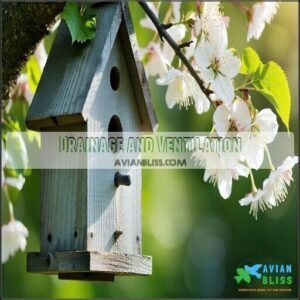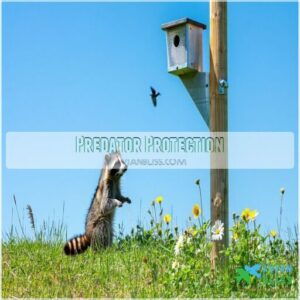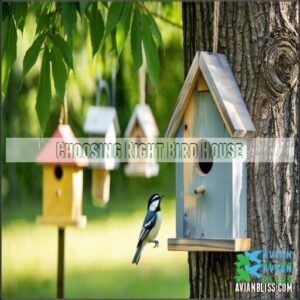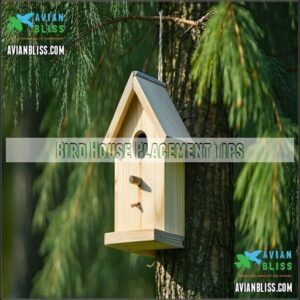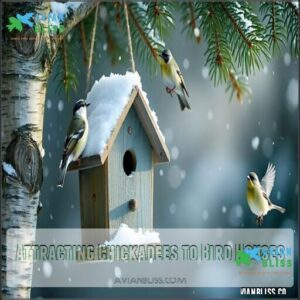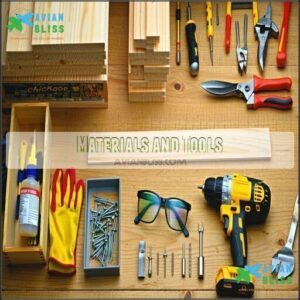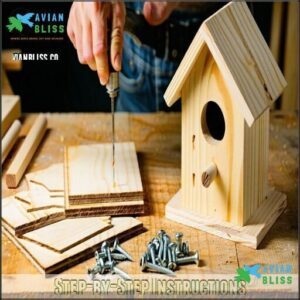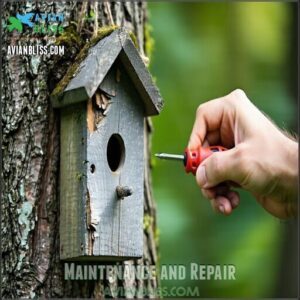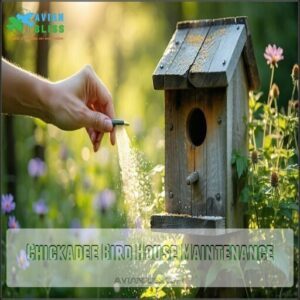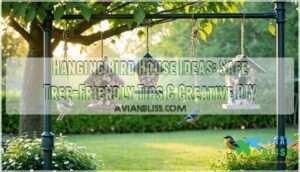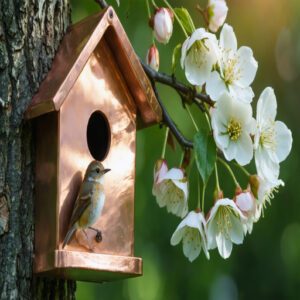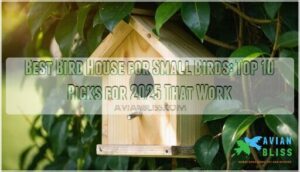This site is supported by our readers. We may earn a commission, at no cost to you, if you purchase through links.
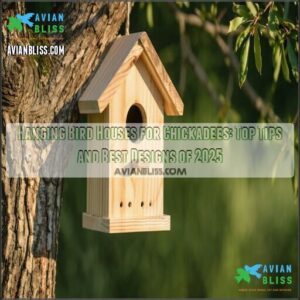
Start with a small, circular entrance hole—1 1/8 inches keeps out larger birds while fitting chickadees perfectly.
Use untreated wood like cedar for a natural, breathable structure.
Place the house 5–15 feet high, ideally facing east or south to avoid harsh winds.
Don’t forget drainage holes and a snug fit to keep water out.
Mount or hang it near shrubs or trees for easy cover, but keep it safe from predators like cats.
Curious about ideal designs and placement tips? There’s more to explore!
Table Of Contents
- Key Takeaways
- Hanging Bird House Basics
- Chickadee Bird House Designs
- Choosing Right Bird House
- Top 9 Chickadee Bird Houses
- 1. Recycled Bird House Wren Chickadee Nest
- 2. Kingsyard Green Bird House Predator Guard
- 3. Woodlink Cedar Wren Chickadee Birdhouse White
- 4. Natural Wood Wren Chickadee Birdhouse
- 5. Distressed Three Tier Hanging Birdhouse
- 6. Cedar Wren House Nature’s Way
- 7. Dreyoo Wren House Metal Guard
- 8. Cedar Bluebird House Hanging Birdhouse
- 9. Cedar Bird House with Copper Guard
- Bird House Placement Tips
- Attracting Chickadees to Bird Houses
- DIY Bird House Building
- Chickadee Bird House Maintenance
- Frequently Asked Questions (FAQs)
- Will chickadees use a hanging birdhouse?
- What direction should a chickadee house face?
- How to attract chickadees to a bird house?
- How to prevent birdhouses from swaying in wind?
- What types of trees attract chickadees nearby?
- Do birdhouses need insulation for colder climates?
- How to safely relocate an occupied birdhouse?
- Can bright colors deter chickadees from nesting?
- Conclusion
Key Takeaways
- Use an untreated wood birdhouse with a 1-1/8 inch entrance hole to keep chickadees safe and exclude larger birds.
- Hang the birdhouse 5–15 feet high, facing east or south to avoid harsh winds and provide warmth.
- Add drainage holes and ventilation slots to keep the interior dry and fresh for nesting birds.
- Place the birdhouse near shrubs or trees for cover but away from predators like cats.
Hanging Bird House Basics
You’ll want to start with the right birdhouse size and features to make chickadees feel at home.
A key detail is the entrance hole, which should be 1-1/8 inches wide to keep these tiny guests happy and safe.
Entrance Hole Size
The entry hole size is critical for a chickadee-friendly birdhouse.
Stick to the ideal diameter of 1-1/8 inches to guarantee sparrow exclusion and limit predator access.
Proper hole placement matters too—center it 6 inches above the floor.
- Keeps predators out
- Fits chickadees while excluding larger species
- Supports multiple species like wrens
Consider birdhouse hole products for ideal design.
A perfect fit makes all the difference!
Interior Dimensions
When choosing chickadee birdhouse dimensions, interior space is key. The ideal depth is 8-10 inches, with a 4×4-inch floor space.
Shape matters—stick to square designs for nesting comfort. Proper volume calculation guarantees enough room without overheating.
Add soft nesting material like moss or wood shavings to create a cozy chickadee birdhouse interior. Entrance hole size is also vital for safety. Small adjustments make a big difference!
Materials and Construction
Once you’ve nailed the interior dimensions, picking the right birdhouse materials is key.
Cedar birdhouses are a favorite for their insulation factors and weatherproofing. Sustainable materials like red cedar or plywood work well, while joint strength improves with screws and glue.
Skip paint inside—chickadees hate fumes. For DIY birdhouses, prioritize sturdy wood and thoughtful construction to keep nests cozy.
Many builders source pre-made cedar options for convenience, considering the importance of weatherproofing.
Chickadee Bird House Designs
You’ll want a birdhouse that’s just the right size and design to keep chickadees safe and comfortable.
Features like proper ventilation, drainage, and a snug 1-1/8 inch entrance hole make all the difference for these tiny, energetic birds, providing them with safe living conditions.
Drainage and Ventilation
You’ve got the entrance hole sorted, but don’t forget drainage and ventilation—two unsung heroes of chickadee birdhouses.
Drainage Importance can’t be overstated; without it, rainwater pools and invites mold. Ventilation Benefits keep air circulating, preventing stuffy interiors and ensuring Material Breathability.
Add small drainage holes at the base and ventilation slots near the roof for proper Airflow Design.
Many retailers offer suitable drainage products for this purpose.
Think of it like giving your chickadees a cozy cabin with fresh air and no soggy floors. They’ll thank you by sticking around!
Predator Protection
Protecting chickadees from predators is essential for a safe nesting environment.
A few clever tricks can make all the difference:
- Baffle Design: Install baffles below the chickadee birdhouse to deter climbing predators.
- Entrance Guards: Use metal or copper guards around the entry hole to prevent chewing or pecking.
- Location Safety: Mount birdhouses 5-15 feet high, away from high-traffic areas.
- Camouflage Techniques: Blend natural wood designs with surroundings for stealth.
- Monitoring Strategies: Regularly inspect for signs of predators or invasive species.
Your chickadees will thank you!
Choosing Right Bird House
When choosing a birdhouse for chickadees, you’ll want to focus on size, shape, and essential features like drainage and ventilation.
A well-designed house but also keeps them safe and makes your yard their favorite nesting spot.
Size and Shape
When picking a chickadee birdhouse, size and shape matter.
Aim for ideal dimensions like a 4×4-inch floor area and an 8-10 inch height. The entry hole size should be 1-1/8 inches, placed higher to keep predators out.
Shape impacts comfort—stick to simple, boxy designs. A snug birdhouse size helps retain heat, perfect for nesting season.
Color and Texture
When choosing a chickadee birdhouse, color and texture matter more than you’d think.
Natural camouflage, like wood grain, blends with the environment and keeps predators at bay. Painted finishes can add charm but stick to muted tones—bright colors may deter birds.
Texture variety in the wood adds a rustic touch while aligning with birdhouse aesthetics and functionality. **Consider handmade birdhouses for artisan craftsmanship and unique garden designs.
Features and Accessories
When picking chickadee birdhouse features, focus on practical accessories.
Insulation materials help chicks stay cozy, while predator baffles and guards keep nests safe.
Skip perches—they’re predator invitations.
Decorative elements can add charm, but make certain they don’t block ventilation.
Consider mounting options for stability and even camera integration to watch chickadees thrive.
Always prioritize a proper birdhouse entrance hole size.
Top 9 Chickadee Bird Houses
You’ll want a birdhouse that’s the perfect fit for chickadees, combining safety, comfort, and durability.
These top nine designs tick all the boxes, offering features like proper ventilation, predator guards, and natural wood construction.
1. Recycled Bird House Wren Chickadee Nest
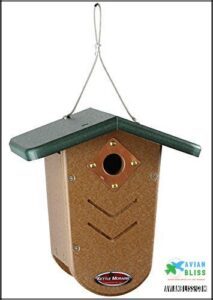
The Recycled Bird House Wren Chickadee Nest is a clever choice for eco-conscious bird lovers.
Made from recycled milk jugs, it’s both sturdy and sustainable.
Its 1-1/8" entrance hole keeps pesky larger birds out while inviting chickadees and wrens.
The side opening makes cleaning a breeze, and built-in drainage and ventilation keep nests dry and comfy.
Whether hung with its stainless steel cable or post-mounted, it’s ready for any outdoor condition.
Plus, it supports sustainability without sacrificing quality or charm.
Best For: Eco-conscious bird enthusiasts looking to attract chickadees and wrens with a durable and sustainable birdhouse.
- Limited to smaller bird species due to 1-1/8" entry hole.
- May require specific installation tools for post-mounting.
- Slightly higher cost compared to non-recycled options.
- Made from recycled materials, promoting sustainability.
- Easy to clean with a side opening.
- Predator-resistant design with copper portal for added safety.
2. Kingsyard Green Bird House Predator Guard
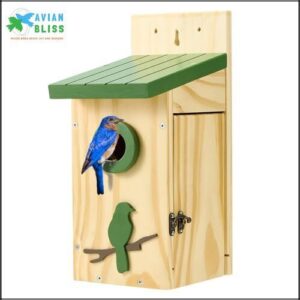
Kingsyard’s Green Bird House with predator guard is like a fortress for your feathered friends.
It’s built to keep out unwanted visitors while giving chickadees a cozy, safe spot to nest. The wooden extension around the entrance hole acts as a shield, protecting baby birds from aggressive predators.
Made from solid New Zealand Pine, it’s sturdy and natural, blending perfectly with your garden.
Ventilation holes and a viewing panel make your birdwatching fun and stress-free. It’s simple, durable, and a bird lover’s dream!
Best For: Bird enthusiasts and garden lovers seeking a durable, predator-resistant birdhouse for small nesting birds.
- Solid New Zealand Pine construction ensures durability and long-lasting use.
- Predator guard protects young birds from potential threats.
- Transparent viewing panel allows observation without disturbing the birds.
- Limited to smaller bird species like chickadees and wrens.
- Only available in two colors, which may limit aesthetic preferences.
- Lack of user reviews makes it hard to gauge long-term reliability.
3. Woodlink Cedar Wren Chickadee Birdhouse White
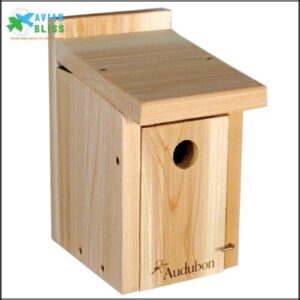
The Woodlink Cedar Wren Chickadee Birdhouse White is a solid choice for attracting chickadees to your yard.
Made from durable cedar, it blends naturally with outdoor surroundings while resisting the elements.
Its well-positioned 1 1/8-inch entrance hole is perfect for small birds like chickadees and wrens.
Ventilation and drainage features help maintain a safe, comfortable environment inside.
While pre-drilled for easy mounting, you’ll need additional tools for predator guards or climbing grooves.
Its natural design guarantees birds feel right at home.
Best For: Homeowners or backyard enthusiasts looking to attract chickadees and wrens with a durable, natural-looking birdhouse.
- Made of durable cedar that resists weather and blends with outdoor surroundings.
- Pre-drilled for easy mounting and designed specifically for small birds.
- Ventilation and drainage maintain a safe and comfortable environment.
- No included predator guard or climbing grooves for fledglings.
- Some units may have misaligned doors or gaps requiring adjustments.
- Mounting screws not included, requiring additional purchases.
4. Natural Wood Wren Chickadee Birdhouse
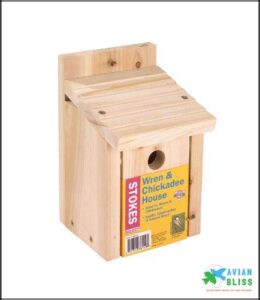
The Natural Wood Wren Chickadee Birdhouse is a cozy choice, fitting perfectly into any yard.
Crafted from durable rough sawn pine, it offers a safe space for chickadees to raise their young.
Its hinged roof makes cleaning a snap, while the removable bottom simplifies maintenance even more.
Thoughtfully designed with an Audubon Society-approved style, it mimics natural nesting conditions.
A small perch peg adds charm, though not essential for chickadees.
This birdhouse blends rustic charm with practicality, attracting happy feathered tenants.
Best For: Nature lovers and bird enthusiasts who want a durable, eco-friendly birdhouse for chickadees and wrens.
- Sturdy construction with natural wood for long-lasting use.
- Hinged roof and removable bottom for easy cleaning.
- Designed with Audubon Society recommendations for optimal bird safety.
- May require periodic maintenance due to natural wood materials.
- Predator guard effectiveness depends on proper installation.
- Perch peg is decorative but unnecessary for chickadees.
5. Distressed Three Tier Hanging Birdhouse
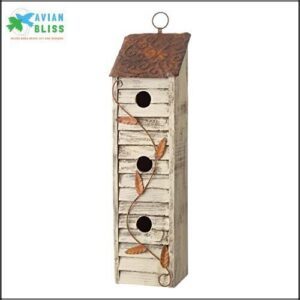
The Distressed Three Tier Hanging Birdhouse combines charm and practicality, making it a standout choice for your yard.
Handcrafted from natural wood and reinforced with metal, its rustic design features a three-tier structure and weather-resistant finish.
The soft green sides and chipped paint give it vintage appeal, effortlessly blending into garden settings.
With an easy-open back for cleaning and a hanging ring for simple installation, it’s functional and decorative.
Perfect for chickadees, it’s a cozy, stylish nesting spot they’ll love.
Best For: Bird and gardening enthusiasts looking for a functional, decorative, and weather-resistant birdhouse that blends seamlessly with garden aesthetics.
- Handcrafted rustic design with a charming vintage look.
- Easy to install and clean with a hanging ring and open-back panel.
- Weather-resistant materials ensure durability in outdoor settings.
- Requires seasonal cleaning for new bird guests.
- Needs protection from severe weather despite its weather-resistant design.
- Limited availability and may sell out quickly.
6. Cedar Wren House Nature’s Way
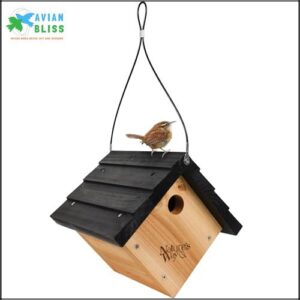
A great option for chickadees, the Cedar Wren House by Nature’s Way is both functional and durable.
Its natural cedar construction resists rotting and pests, keeping it cozy for birds. The 1 1/8" entrance hole excludes larger birds while welcoming chickadees.
Ventilation slots guarantee fresh air, and drainage holes keep the nest dry during rain. It’s not just about design—it offers proper insulation and safety.
Simple to mount, this birdhouse blends perfectly into wooded backyards, making it an inviting home for feathered friends.
Best For: Backyard bird enthusiasts looking to attract chickadees and wrens with a durable, pest-resistant birdhouse.
- Limited to attracting only wrens and chickadees.
- No detailed instruction on mounting or placement options included.
- Weather resistance only specified as rot-resistant, not fully waterproof.
- Made from premium cedar, naturally resistant to rot and pests.
- Includes 1 1/8" entrance hole to prevent access by larger birds.
- Easy-to-open design for convenient cleaning and maintenance.
7. Dreyoo Wren House Metal Guard
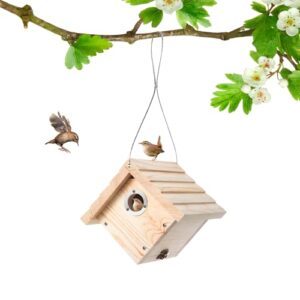
The Dreyoo Wren House Metal Guard is a fantastic option for chickadees and other small birds.
Its 1-1/8" entry hole, protected by a metal guard, keeps predators out while ensuring a safe nesting space.
Made from durable cedar wood, it’s designed to withstand the weather and includes air vent grooves for proper ventilation.
The easy-to-clean bottom panel simplifies maintenance, making it a breeze to provide a healthy environment for your feathered friends.
This house combines safety, durability, and convenience beautifully!
Best For: Homeowners looking to attract wrens, chickadees, and other small birds while ensuring their safety and comfort.
- Durable cedar wood and weather-resistant materials for outdoor use.
- Metal guard prevents predators and ensures bird safety.
- Easy-to-clean bottom panel for hassle-free maintenance.
- Limited to small bird species like wrens and chickadees.
- Requires proper placement on tree limbs or poles for effectiveness.
- Higher price point compared to some alternatives.
8. Cedar Bluebird House Hanging Birdhouse
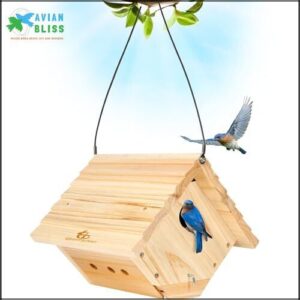
The Cedar Bluebird House Hanging Birdhouse’s thoughtful design makes it a cozy choice for chickadees.
With its durable cedar construction and solid walls, it stands up to weather while providing a safe haven. Nine air vents keep the interior fresh, and a removable bottom panel simplifies cleaning—chickadees love a tidy home!
Its hanging feature allows versatile placement in trees or patios. Plus, the sturdy roof offers protection, and the 1-year warranty adds peace of mind for birders looking to attract feathered friends.
Predator guards are essential for bluebird safety.
Best For: Nature lovers and birdwatching enthusiasts who want a durable, easy-to-maintain birdhouse for small bird species like chickadees, wrens, and house finches.
- Limited to smaller bird species, not suitable for larger birds.
- Requires regular maintenance to ensure cleanliness.
- Predator guards sold separately for additional safety.
- Durable cedar wood construction with weather resistance.
- Removable bottom panel for easy cleaning and maintenance.
- Nine air vents for optimal ventilation and bird comfort.
9. Cedar Bird House with Copper Guard
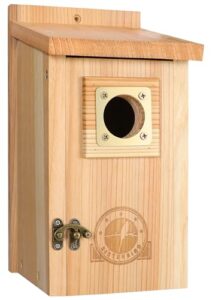
The Cedar Bird House with Copper Guard is a solid pick for chickadees.
Its 7/8-inch thick cedar construction offers excellent durability, while the copper guard deters predators and preserves the entry hole’s size.
The rough-textured wood helps chicks grip as they explore, making fledging safe and easy.
Designed for weather resistance, this house won’t crack or rot.
With its simple upkeep and natural look, this birdhouse blends right into your yard while giving your feathered neighbors a cozy nesting spot.
Best For: Nature enthusiasts looking for a durable, predator-resistant birdhouse for small bird species like chickadees or bluebirds.
- Roof could be larger for better rain and sun protection.
- No perch, which may not appeal to some users.
- Limited to specific bird species due to entry hole size.
- Durable 7/8-inch thick cedar construction for long-lasting use.
- Copper guard protects against predators and maintains the entry hole.
- Rough-textured wood assists fledglings in safely exiting.
Bird House Placement Tips
If you’re hanging a birdhouse for chickadees, placement is everything.
Choose a spot at the right height, facing away from strong winds, and surrounded by natural cover to keep them safe and comfortable.
Height and Location
For a Chickadee birdhouse, the ideal height is 5 to 15 feet, with 6 feet being a sweet spot.
This nesting height reduces predator risks while mimicking natural cavities.
Choose calm, wooded habitats for birdhouse placement where weather exposure is minimal.
Secure mounting options, like attaching to trees, guarantee stability, and Chickadees thrive in quiet spots, far from heavy activity or predators.
Direction and Orientation
Facing your Chickadee birdhouse matters for their comfort and safety.
Follow these tips for perfect orientation:
- Face the birdhouse away from prevailing winds to reduce drafts.
- Make certain sunlight exposure in the morning for warmth.
- Align with local climate needs—shade in hotter regions.
- Point to sheltered spots for predator avoidance.
- Mimic natural habitats by facing in the direction of thickets or trees nearby.
Mounting heights influence chickadee habitation.
Surrounding Environment
Pick a quiet, wooded area with plenty of vegetation cover for your chickadee birdhouse.
Avoid spots near heavy human activity or competing species. Place the birdhouse where it’s shielded from weather exposure and predator access—like near a tree trunk.
A balanced birdhouse habitat guarantees safety while mimicking natural conditions.
Careful birdhouse placement creates a welcoming refuge for these tiny birds, ensuring a safe environment.
Attracting Chickadees to Bird Houses
You can attract chickadees to your bird house by creating a safe environment.
Simple things like offering sunflower seeds or planting native shrubs make all the difference for these charming little birds, providing them with proper food, water, and shelter.
Food and Water Sources
Provide sunflower seeds or suet feeders near your chickadee birdhouse to attract these charming backyard birds.
Fresh water availability matters too—add a shallow bowl or birdbath for easy access.
Chickadees also savor insect larvae and peanut butter, so mix those into bird feeders for variety.
It’s fun bird watching when your yard becomes a snack haven for little feathered visitors!
Native Plants and Shrubs
Give chickadees the perfect backyard by planting native shrubs like birch, oak, and juniper.
These berry-producing shrubs and insect-attracting plants provide year-round nesting cover, winter food, and shelter options.
Pair these birdhouse shrubs with a chickadee birdhouse and watch nesting chickadees thrive, creating a cozy neighborhood where nature’s tiniest tenants feel right at home, and think of it as a place where they can thrive.
Avoiding Pesticides
Creating a safe habitat for chickadees means avoiding pesticides completely.
These chemicals harm insect populations, which are essential for chickadees’ diet. Instead, focus on eco-friendly practices like organic gardening or encouraging natural predators such as ladybugs and birds of prey.
By using pesticide alternatives, you’ll support thriving ecosystems while ensuring your chickadee birdhouse remains a cozy, welcoming home for these cheerful flyers, which is crucial for creating a safe habitat.
DIY Bird House Building
Building your own birdhouse for chickadees lets you customize every detail, from the materials to the design.
With just a few tools, some sturdy wood, and a little patience, you can create a safe, comfortable home that meets their specific needs.
This allows for a customized approach to building the birdhouse, ensuring it is tailored to the chickadees’ requirements.
Materials and Tools
Building a chickadee birdhouse? Start with natural materials like cedar or pine—they’re sturdy and perfect for nesting.
Use galvanized screws for secure joints and wood glue for extra strength. A cutting tool, like a table saw, guarantees precise shaping, while a drill handles entry holes.
Don’t forget safety gear—splinters aren’t fun! A little care goes a long way, and using the right materials, like galvanized screws, will ensure your birdhouse is both safe and durable.
Step-by-Step Instructions
Start your diy birdhouse with precision. First, cut wood into panels for sides, a base, and a sloped roof.
Next, drill a hole (1 1/8") for the entrance. Then, assemble the box using screws and waterproof glue.
- Attach the roof with hinges for easy cleaning.
- Add ventilation slots and drainage holes.
- Use sturdy mounting hardware for secure birdhouse installation.
Maintenance and Repair
After building your chickadee birdhouse, keep it safe and cozy with regular birdhouse maintenance. Check for material degradation, damage, or pest infestation annually.
Cleaning frequency matters—clear out old nests and debris in fall. A quick scrub improves ventilation and drainage too.
Here’s a checklist:
| Task | When | Why It Helps |
|---|---|---|
| Birdhouse Cleaning | Every Fall | Prevents mold and pests |
| Damage Assessment | Biannually | Guarantees structural safety |
| Repair Techniques | As Needed | Keeps predators away, ensuring complete protection and safe habitats for the birds. |
Chickadee Bird House Maintenance
Keeping your chickadee bird house in top shape means cleaning it out yearly and regularly checking for damage or unwanted visitors.
A little effort guarantees a safe, cozy home, giving your feathered tenants the best chance to thrive.
Cleaning and Disinfecting
Once your DIY birdhouse is built, birdhouse maintenance is essential.
Cleaning frequency keeps bacteria growth and parasites in check.
Follow these steps:
- Empty old nests and debris.
- Scrub with a safe solution like diluted chlorine bleach.
- Dry in sunlight to prevent mold.
- Dispose of waste properly to avoid attracting pests.
- Inspect for cracks during birdhouse sanitization.
Dispose of waste properly to avoid attracting pests is crucial for the overall health of the birds, and proper maintenance ensures the birdhouse remains a safe haven.
Predator Control
Predators can turn your chickadee birdhouse into an easy meal station, but smart predator protection keeps them out.
Use baffle designs or predator guards around mounting poles to block climbing threats.
Entrance guards limit access to the small opening, safeguarding chicks.
Habitat management works, too—avoid placing the birdhouse near brush piles or feeders to discourage lurking predators.
Monitor threats regularly.
Regular Inspection and Repair
After keeping predators at bay, it’s wise to check your chickadee birdhouse regularly.
Look for damage, material degradation, or loose parts affecting structural integrity. Birdhouse monitoring should include pest infestation checks.
Repair frequency depends on wear—tighten screws, replace wood if needed, and seal cracks.
A well-maintained hanging birdhouse keeps birds cozy and guarantees your feathered friends thrive safely in a well-maintained environment.
Frequently Asked Questions (FAQs)
Will chickadees use a hanging birdhouse?
Home is where the heart is," and chickadees will embrace a hanging birdhouse if it’s secure and positioned right.
Mount it 4-15 feet high, facing away from winds, with proper ventilation and predator protection.
What direction should a chickadee house face?
Face your chickadee house away from prevailing winds, like north or northeast, to shield it from harsh weather.
This direction provides extra warmth and protection, creating a cozy and inviting spot for nesting chickadees.
How to attract chickadees to a bird house?
Think of your birdhouse like a cozy hotel—offer sunflower seeds, suet, and fresh water nearby.
Place it 4-15 feet high in quiet spots with soft nesting material inside.
Clean it annually for returning guests.
How to prevent birdhouses from swaying in wind?
Secure birdhouses by attaching them to sturdy tree trunks or mounting poles using brackets or screws.
Avoid suspending them with ropes or wires, as swaying risks eggs and chicks.
Stability guarantees a safer, cozier home.
What types of trees attract chickadees nearby?
Chickadees love trees like birch, alder, and willow.
These provide natural nesting spots, bugs for meals, and cover from predators.
Adding native shrubs nearby boosts appeal, creating a bird-friendly space they’ll adore, with cozy surroundings.
Do birdhouses need insulation for colder climates?
Chilly climates call for cozy chickadee houses.
Insulation isn’t strictly required but helps retain warmth.
Thick walls, natural wood, and a snug design shield them from frost, keeping these feathered friends safe without cranking up the birdhouse “heat”, which is a key factor in providing a cozy environment.
How to safely relocate an occupied birdhouse?
Gently relocate the birdhouse at night to reduce stress, keeping its orientation the same.
Move it short distances to a similar spot, like a nearby tree.
Avoid jostling; chickadees are sensitive to sudden changes.
Can bright colors deter chickadees from nesting?
Ever wonder if flashy colors scare chickadees away?
Bright hues can make them cautious, as they prefer natural tones that blend with surroundings.
Stick to muted wood shades to keep them feeling safe and cozy.
Conclusion
Did you know chickadees can fit in spaces as small as 1 1/8 inches?
When hanging bird houses for chickadees, stick to precise designs and thoughtful placement.
Opt for untreated wood, add drainage holes, and position the house 5–15 feet high, facing east or south.
Keep it near shrubs for cover but away from predators, to create a safe spot for these charming birds to nest and thrive in your yard.


